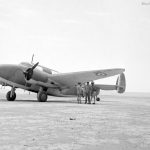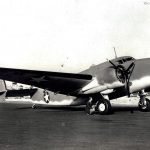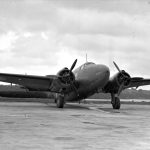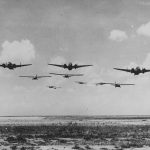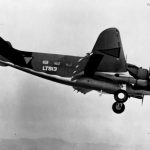SAAF Lodestar Flying Ambulance
Evacuation plane with a Red Cross Lodestar 1371
RAAF Lodestar 37 Sqn Noemfoor
R5O-6 Lodestar BuNo 39619
R5O-5 naval staff transport
Lodestar NZ3510 in service with the RNZAFduring the war
British Lodestar II 117 Sqn, Middle East 1942
Lodestar aircraft being refuelled at Juba
Lodestars towing Waco Gliders
Lodestars towing Waco Gliders Texas
Lockheed XR5O-1 V-188 Cape May
Lockheed XR5O-1
French C-60 Lodestar
Field Marshal Smuts
Dutch Lodestar with Fowler flaps extended
C-60 Lodestar 1942
C-60A
C-60
In 1939, Lockheed Aircraft Corporation decided to complete its family of high-speed twin-engine passenger aircraft with a new, larger capacity aircraft. This was prompted by a competitive battle with the Douglas company, which was successfully selling their Douglas DC-3 (DST) aircraft both in the USA and abroad. The new aircraft, named the Lockheed L-18 “Lodestar”, used many design elements from the previous Lockheed L-14 “Super Electra” design, including the wing almost entirely. However, the fuselage was new, longer and higher, accommodating 15-18 passengers, in further versions the number of passengers was increased to 26. In order to meet the requirements of potential customers a number of versions were developed with different engines of Pratt & Whitney (L-18-07, L-18-08, L-18-10, L-18-14) and Wright (L-18-40, L-18-50, L-18-56) with power from 490 hp to 650 hp. Three “Lodestar” prototypes were built as a result of the conversion of serial Lockheed L-14H aircraft. The first of them was flown on 21. September 1939. The first serial aircraft took to the air on 02. February, 1940.
The exploitation of the L-18 began in March 1940. However, the plane was not very popular in the USA, most of the airlines used the slower, but more capacious DC-3 planes. Only 43 planes (including the improved versions L-118 and L-218) were sold to various airlines, the largest number was purchased by Pan Am – 12 planes. A further 96 aircraft were sold abroad, including 38 to Great Britain and 29 to South Africa. They were also used in Brazil, Canada, France, the Dutch East Indies (today’s Indonesia), Norway and Venezuela.
In May 1941, the USAAF purchased one L-18-20 (under the designation C-56) and three L-18-14s (as C-57), followed by a further 10 C-57s. The C-57 were ordinary passenger aircraft used to transport staff officers. When the USA entered the Second World War, a number of Model 18 aircraft of various versions were purchased for military aviation. In 1941-1943 the large-scale production of aircraft for the transport aviation developed.
Versions built for USAAF:
– C-56- powered by 760 hp Wright R-1820 engines, 1 example was built,
– C-56A, C-56B, C-56C, C-56D, C-56E – versions powered by the engines Pratt & Whitney R-1690. 25 copies were built,
– C-57A – powered by the engines Pratt & Whitney R-1830. 1 example was built,
– C-57B – powered by Pratt & Whitney R-1830 engines. 7 examples were built,
– C-57C- variant C-60A powered by Pratt & Whitney R-1830-51 engines. 3 examples were built,
– C-57D – C-57A variant powered by Pratt & Whitney R-1830-92 engines. 1 built,
– C-59 (RAF Mk.IA)- a version powered by Pratt & Whitney R-1690 “Hornet” engines. 10 copies were built,
– C-60 (RAF Mk.II)- powered by Wright R-1820-87 engines. 36 examples were built,
– C-60A – powered by the engines Pratt & Whitney R-1830 “Twin Wasp”. 125 were built.
– XC-60B- a variant of the C-60A with an experimental anti-icing system. 1 example built,
– C-60C- project of a transport aircraft designed for transport of 21 soldiers, was not realized,
– C-66- powered by Wright R-1820-87 engines. 1 aircraft built, donated to Brazilian military aviation.
Versions built for the US Navy:
– XR5O-1- powered by Wright R-1820-40 engines with 895 kW. 1 example built,
– R5O-1- powered by Wright R -1820-97 engines with 895 kW. 3 examples were built, one was transferred to United States Coast Guard,
– R5O-2- powered by Pratt & Whitney R-1690-25 engines with power 634 kW. 1 ex. was built,
– R5O-3- powered by Pratt & Whitney R-1830-34A engines with 895 kW. Initially it was a VIP transport aircraft for 4 passengers. There were built 4 examples,
– R5O-4- powered by Wright R-1820-40 engines with power 895 kW. It was a staff transport plane for 7 passengers. There were 12 built,
– R5O-5- powered by Wright R-1820-40 engines with 895 kW. Similar to R5O-4 but with seats for 14 passengers. 14 examples were built,
– R5O-6- designation of 35 aircraft C-60A-5-LO which were transferred by USAAC to the US Navy (USMC), they took 18 soldiers on board.
In 1941-1943 the large-series production of the planes for the transport aviation was started. For USAAF there were built 10 ex. C-59, 30 ex. C-60 (15 of them were given to Great Britain) and 325 C-60A. C-60A. They had simplified equipment of passenger cabin and reinforced floor. The planes were unarmed, in the C-60 and C-60A versions there were openings in the cabin windows for fire from the airborne small arms. About 100 copies were delivered to the aviation of the United States Navy. In total 625 aircrafts of the Lockheed Model 18 family were built.
The transport aircrafts of Lockheed Model 18 family were used in the military aviation: Australia, Brazil, Dutch East Indies, Canada, New Zealand, Norway, South Africa, USA, UK.
On the basis of the aircraft Lockheed Model 18 Lodestar there was constructed a maritime patrol aircraft Ventura.
General Specifications
- Type: Twin-engined transport plane.
Wings
- Configuration: Mid-wing cantilever monoplane of single-spar construction.
- Sections: Composed of three sections with integral fuel tanks in the center-section.
- Flaps and Ailerons: Equipped with Fowler flaps. Ailerons are interconnected to droop with the flaps.
Fuselage
- Structure: Elliptical cross-section monocoque of all-metal construction.
Tail Unit
- Configuration: Cantilever monoplane type with twin fins and rudders.
Landing Gear
- Type: Hydraulically-operated retractable type. Can be lowered in six seconds at speeds up to 250 mph. Features low-pressure tires and hydraulic disc brakes, along with pneumatic hydraulic shock-absorbers.
Power Plant (C-60A)
- Engines: Two Wright R-1820-87 nine-cylinder radial air-cooled engines.
- Power Output: Rated at 1,000 hp at 14,200 ft (4,330 m) and 1,200 hp available for take-off.
- Propellers: Hamilton-Standard constant-speed hydromatic airscrews.
- Fuel and Oil Capacity:
- Fuel tanks with a total maximum capacity of 644 U.S. gallons (536 Imperial gallons = 2,438 liters).
- Maximum oil capacity of 44 U.S. gallons (36.6 Imperial gallons = 166.5 liters).
Accommodation (C-60A)
- Crew: Consists of three members — pilot, co-pilot, and radio operator.
- Passenger Capacity: Benches in the cabin can accommodate eighteen troops or other personnel.
- Cabin Dimensions: 28 ft. (8.54 m) long, 5 ft. 5½ in. (1.7 m) wide, and 6 ft. 3 in. (1.9 m) high.
Dimensions
- Span: 65 ft. 8 in. (19.96 m)
- Length: 49 ft. 9½ in. (15.19 m)
- Height: 11 ft. 10½ in. (3.6 m)
- Wing Area: 551 sq. ft. (51.2 sq. m)
Weights (C-60A)
- Empty Weight: 12,075 lbs. (5,480 kg)
- Normal Loaded Weight: 18,500 lbs. (8,400 kg)
- Maximum Overloaded Weight: 21,500 lbs. (9,760 kg)
Performance (C-60A)
- Maximum Speed: 266 mph (425.6 km/h) at 17,000 ft. (5,185 m)
- Cruising Speed: 200 mph (320 km/h)
- Climb to 10,000 ft. (3,050 m): 6.6 minutes
- Service Ceiling: 30,000 ft. (9,150 m)
- Range: 1,660 miles (2,660 km) with a full complement and maximum fuel.

